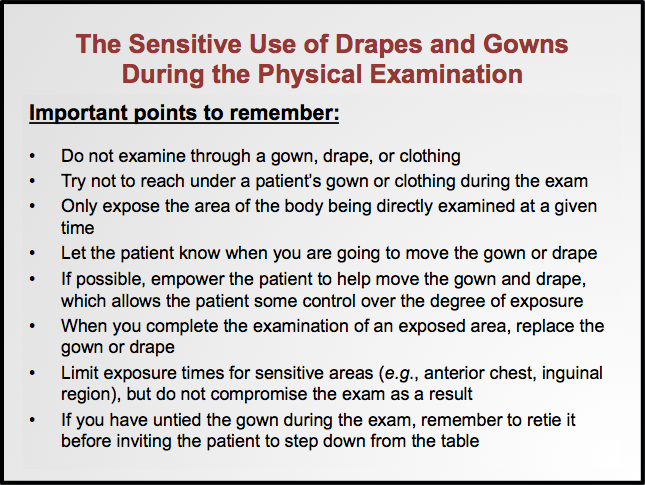Proper Adjustment of Patient Attire during the Physical Exam
Genel Bakış
Source: Jaideep S. Talwalkar, MD, and Joseph Donroe, MD, Internal Medicine and Pediatrics, Yale School of Medicine, New Haven, CT
In order to optimize the predictive value of the physical examination, the provider must perform maneuvers correctly. The proper use of drapes is an important component of correctly performing physical examination maneuvers. Skin lesions are missed when "inspection" occurs through clothing, crackles are erroneously reported when the lungs are examined through a t-shirt, and subtle findings on the heart exam go undetected when auscultation is performed over clothing. Accordingly, the best practice standards call for examining with one's hands or equipment in direct contact with the patient's skin (i.e., do not examine through a gown, drape, or clothing). In addition to its clinical value, the correct draping technique is important for improving the patient's comfort level during the encounter.
Like all other aspects of the physical exam, it takes deliberate thought and practice to find the right balance between draping, which is done to preserve patient modesty, and exposure, which is necessary to optimize access to the parts that need examination. Individual provider styles in the use of gowns and drapes vary considerably based on the site of practice, resource availability, and discipline within medicine. This video provides a general overview of some of the most common techniques used, combining techniques that utilize common draping approaches.
Prosedür
1. Maneuvers that can be performed while the patient is wearing street clothing
Note that some aspects of the physical exam can be performed on patients while they are wearing street clothing that permits exposure of the region to be inspected. These maneuvers include the measurement of the vital signs, general appearance, the HEENT (Head, Eyes, Ears, Nose, and Throat) exam, the neck exam, the abdominal exam, the vascular exam, and the neurological exam.
- To take a measurement of th
Başvuru ve Özet
The sensitive use of gowns and drapes during the physical examination is important to strike a balance between patient comfort and exposure (Figure 1). The examination should not be compromised out of the clinician's concern for patient exposure, since the proper use of draping allows for the proper exam to be performed in most clinical circumstances. Examination through clothing, sheets, or gowns is incorrect technique, though only the areas of the body being directly examined at a given time need to be
Atla...
Bu koleksiyondaki videolar:

Now Playing
Proper Adjustment of Patient Attire during the Physical Exam
Physical Examinations I
83.4K Görüntüleme Sayısı

General Approach to the Physical Exam
Physical Examinations I
117.6K Görüntüleme Sayısı

Observation and Inspection
Physical Examinations I
95.1K Görüntüleme Sayısı

Palpation
Physical Examinations I
84.5K Görüntüleme Sayısı

Percussion
Physical Examinations I
101.8K Görüntüleme Sayısı

Auscultation
Physical Examinations I
62.3K Görüntüleme Sayısı

Blood Pressure Measurement
Physical Examinations I
108.9K Görüntüleme Sayısı

Measuring Vital Signs
Physical Examinations I
115.0K Görüntüleme Sayısı

Respiratory Exam I: Inspection and Palpation
Physical Examinations I
157.5K Görüntüleme Sayısı

Respiratory Exam II: Percussion and Auscultation
Physical Examinations I
213.1K Görüntüleme Sayısı

Cardiac Exam I: Inspection and Palpation
Physical Examinations I
176.7K Görüntüleme Sayısı

Cardiac Exam II: Auscultation
Physical Examinations I
140.1K Görüntüleme Sayısı

Cardiac Exam III: Abnormal Heart Sounds
Physical Examinations I
91.9K Görüntüleme Sayısı

Peripheral Vascular Exam
Physical Examinations I
68.8K Görüntüleme Sayısı

Peripheral Vascular Exam Using a Continuous Wave Doppler
Physical Examinations I
38.6K Görüntüleme Sayısı
JoVE Hakkında
Telif Hakkı © 2020 MyJove Corporation. Tüm hakları saklıdır
